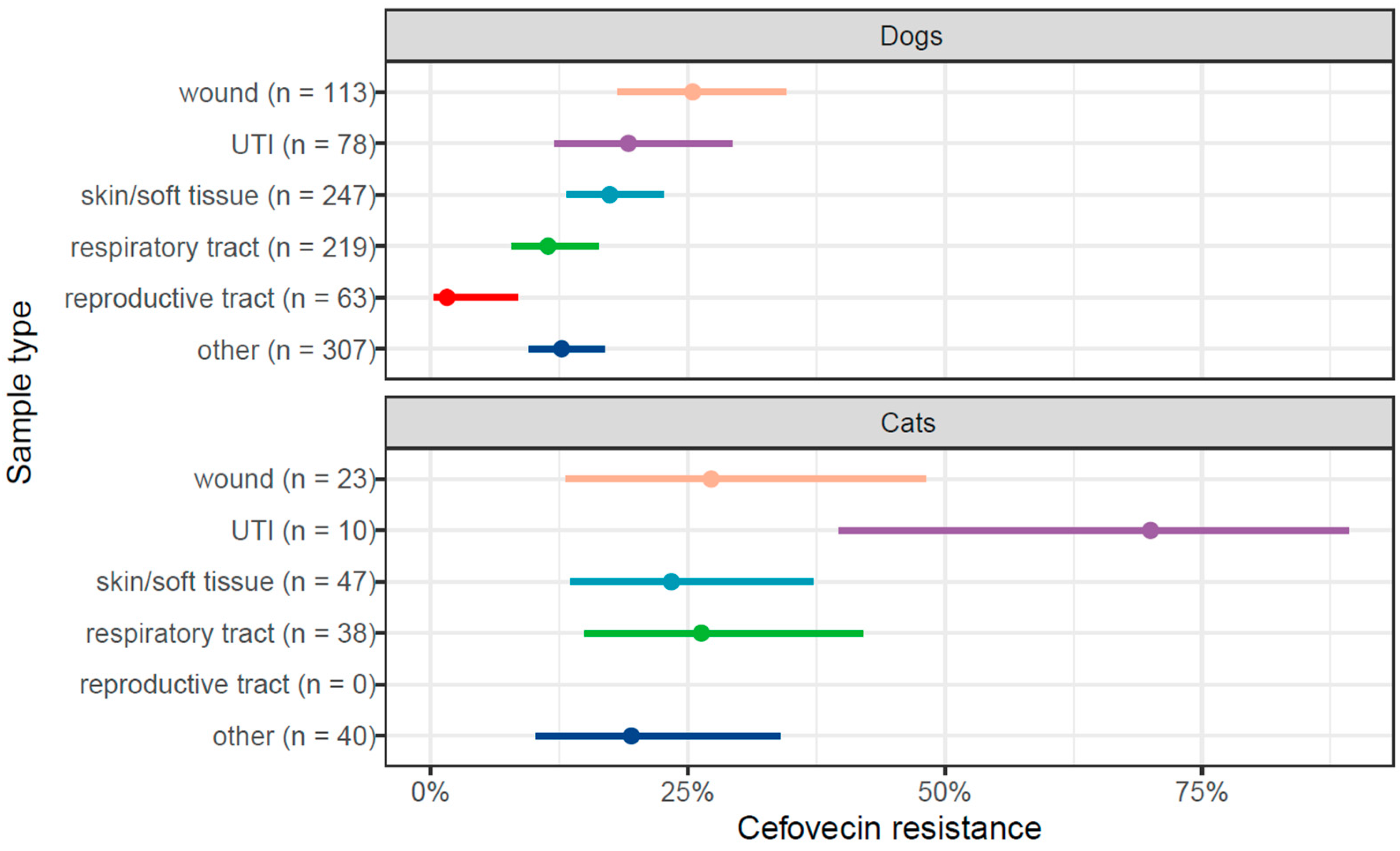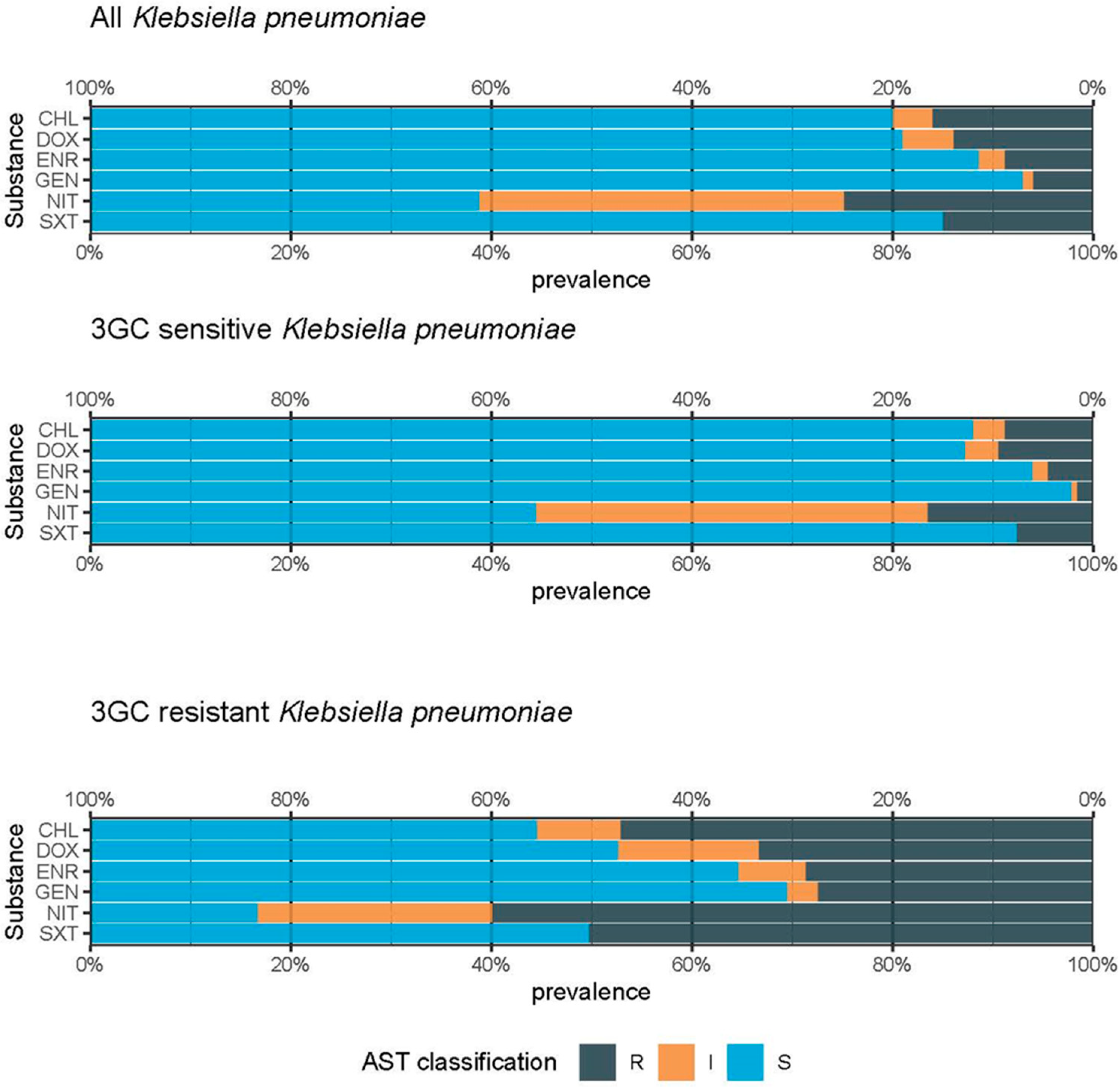Temporal Trends in Antimicrobial Resistance of Klebsiella pneumoniae in Clinically Affected Canine and Feline Populations in Germany: A 2019–2021 Analysis
Abstract
1. Introduction
2. Materials and Methods
2.1. Samples and Sample Processing
2.2. Bacterial Isolation and Identification
2.3. Antimicrobial Susceptibility Testing
2.4. Preparation for Statistical Analysis
2.5. Statistical Analyses
3. Results
4. Discussion
5. Conclusions
Supplementary Materials
Author Contributions
Funding
Institutional Review Board Statement
Informed Consent Statement
Data Availability Statement
Acknowledgments
Conflicts of Interest
References
- European Centre for Disease Prevention and Control; Merk, H.; Diaz Högberg, L.; Plachouras, D.; Suetens, C.; Monet, D.L. Assessing the Health Burden of Infections with Antibiotic-Resistant Bacteria in the EU/EEA, 2016–2020; European Centre for Disease Prevention and Control: Stockholm, Sweden, 2022. [Google Scholar] [CrossRef]
- Ventola, C.L. The antibiotic resistance crisis: Part 1: Causes and threats. Pharm. Ther. 2015, 40, 277–283. [Google Scholar]
- Read, A.F.; Woods, R.J. Antibiotic resistance management. Evol. Med. Public Health 2014, 2014, 147. [Google Scholar] [CrossRef]
- World Health Organization. Global Action Plan on Antimicrobial Resistance; World Health Organization: Geneva, Switzerland, 2015. [Google Scholar]
- European Commission. A European One Health Action Plan against Antimicrobial Resistance (AMR); European Commission: Brussels, Belgium, 2017. [Google Scholar]
- European Parliament. Verordnung (EU) 2019/des Europäischen Parlaments und des Rates vom 11. Dezember 2018 über Tierarzneimittel und zur Aufhebung der Richtlinie 2001/82/EG; European Parliament: Strasbourg, France, 2018. [Google Scholar]
- Bundesministerium für Gesundheit. DART 2030—Deutsche Antibiotika-Resistenzstrategie. Available online: www.bundesgesundheitsministerium.de (accessed on 19 November 2023).
- Bundestag; Act on Veterinary Medicinal Products and on Implementing the Provisions of Union Law Concerning Veterinary Medicinal Products (Veterinary Medicinal Products Act—TAMG). Available online: https://www.bmel.de/SharedDocs/Downloads/DE/_Tiere/Tiergesundheit/Tierarzneimittel/Tierarzneimittelgesetz-EN.pdf?__blob=publicationFile&v=6 (accessed on 20 November 2023).
- Bundesamt für Verbraucherschutz und Lebensmittelsicherheit; BVL-Report. 17.6 Bericht zur Resistenzmonitoringstudie 2021. Available online: https://www.bvl.bund.de/SharedDocs/Berichte/07_Resistenzmonitoringstudie/Bericht_Resistenzmonitoring_2021.pdf?__blob=publicationFile&v=2 (accessed on 13 November 2023).
- Wang, G.; Zhao, G.; Chao, X.; Xie, L.; Wang, H. The Characteristic of Virulence, Biofilm and Antibiotic Resistance of Klebsiella pneumoniae. Int. J. Environ. Res. Public Health 2020, 17, 6278. [Google Scholar] [CrossRef]
- Navon-Venezia, S.; Kondratyeva, K.; Carattoli, A. Klebsiella pneumoniae: A major worldwide source and shuttle for antibiotic resistance. FEMS Microbiol. Rev. 2017, 41, 252–275. [Google Scholar] [CrossRef]
- Ribeiro, M.G.; de Morais, A.B.C.; Alves, A.C.; Bolaños, C.A.D.; de Paula, C.L.; Portilho, F.V.R.; de Nardi Júnior, G.; Lara, G.H.B.; de Souza Araújo Martins, L.; Moraes, L.S.; et al. Klebsiella-induced infections in domestic species: A case-series study in 697 animals (1997–2019). Braz. J. Microbiol. 2022, 53, 455–464. [Google Scholar] [CrossRef]
- Choby, J.E.; Howard-Anderson, J.; Weiss, D.S. Hypervirulent Klebsiella pneumoniae—Clinical and molecular perspectives. J. Intern. Med. 2020, 287, 283–300. [Google Scholar] [CrossRef]
- Anses 2023. Resapath: French Surveillance Network for Antimicrobial Resistance in Bacteria from Diseased Animals. Available online: https://www.anses.fr/en/system/files/LABO-Ra-Resapath2022EN.pdf (accessed on 20 March 2024).
- Bundestierärztekammer, e.V. Statistik 2021: Tierärzteschaft in der Bundesrepublik Deutschland. Dtsch. Tierärztebl. 2022, 70, 762–772. [Google Scholar]
- Schwarz, S.; Mensing, N.; Hörmann, F.; Schneider, M.; Baumgärtner, W. Polyarthritis Caused by Acinetobacter kookii in a Rothschild’s Giraffe Calf (Giraffa camelopardalis rothschildi). J. Comp. Pathol. 2020, 178, 56–60. [Google Scholar] [CrossRef] [PubMed]
- Clinical & Laboratory Standards Institute. M100Ed33|Performance Standards for Antimicrobial Susceptibility Testing, 33rd ed.; Clinical & Laboratory Standards Institute: Berwyn, PA, USA, 2024; Available online: https://clsi.org/standards/products/microbiology/documents/m100/ (accessed on 24 July 2023).
- CLSI. Clinical and Laboratory Standard Institute: CLSI Guidlines: VET01S ED6. Available online: https://clsi.org/ (accessed on 24 July 2023).
- R Core Team. R: A Language and Environment for Statistical Computing. Available online: https://www.R-project.org/ (accessed on 24 July 2023).
- Berends, M.S.; Luz, C.F.; Friedrich, A.W.; Sinha, B.N.M.; Albers, C.J.; Glasner, C. AMR: An R Package for Working with Antimicrobial Resistance Data. J. Stat. Soft. 2022, 104, 1–31. [Google Scholar] [CrossRef]
- Robert-Koch-Institut. ARS—Antibiotika-Resistenz-Surveillance. Available online: https://ars.rki.de/ (accessed on 3 April 2024).
- Araújo, D.; Castro, J.; Matos, F.; Oliveira, R.; Ramos, C.; Almeida, C.; Silva, S. Exploring the prevalence and antibiotic resistance profile of Klebsiella pneumoniae and Klebsiella oxytoca isolated from clinically ill companion animals from North of Portugal. Res. Vet. Sci. 2023, 159, 183–188. [Google Scholar] [CrossRef]
- Harada, K.; Shimizu, T.; Mukai, Y.; Kuwajima, K.; Sato, T.; Usui, M.; Tamura, Y.; Kimura, Y.; Miyamoto, T.; Tsuyuki, Y.; et al. Phenotypic and Molecular Characterization of Antimicrobial Resistance in Klebsiella spp. Isolates from Companion Animals in Japan: Clonal Dissemination of Multidrug-Resistant Extended-Spectrum β-Lactamase-Producing Klebsiella pneumoniae. Front. Microbiol. 2016, 7, 1021. [Google Scholar] [CrossRef]
- Moerer, M.; Merle, R.; Bäumer, W. A Cross-Sectional Study of Veterinarians in Germany on the Impact of the TÄHAV Amendment 2018 on Antimicrobial Use and Development of Antimicrobial Resistance in Dogs and Cats. Antibiotics 2022, 11, 484. [Google Scholar] [CrossRef] [PubMed]
- Schlemmer, A. All Creatures Great and Small: The Impact of the COVID-19 Pandemic on Veterinary Medicine. Available online: https://cedar.wwu.edu/wwu_honors/580 (accessed on 7 August 2024).
- Hardefeldt, L.; Hur, B.; Verspoor, K.; Baldwin, T.; Bailey, K.E.; Scarborough, R.; Richards, S.; Billman-Jacobe, H.; Browning, G.F.; Gilkerson, J. Use of cefovecin in dogs and cats attending first-opinion veterinary practices in Australia. Vet. Rec. 2020, 187, e95. [Google Scholar] [CrossRef] [PubMed]
- Lee, D.; Oh, J.Y.; Sum, S.; Park, H.M. Prevalence and antimicrobial resistance of Klebsiella species isolated from clinically ill companion animals. J. Vet. Sci. 2021, 22, e17. [Google Scholar] [CrossRef]
- Kang, C.-I.; Song, J.-H. Antimicrobial resistance in Asia: Current epidemiology and clinical implications. Infect. Chemother. 2013, 45, 22–31. [Google Scholar] [CrossRef]
- Marques, C.; Menezes, J.; Belas, A.; Aboim, C.; Cavaco-Silva, P.; Trigueiro, G.; Telo Gama, L.; Pomba, C. Klebsiella pneumoniae causing urinary tract infections in companion animals and humans: Population structure, antimicrobial resistance and virulence genes. J. Antimicrob. Chemother. 2019, 74, 594–602. [Google Scholar] [CrossRef] [PubMed]
- Darwich, L.; Seminati, C.; Burballa, A.; Nieto, A.; Durán, I.; Tarradas, N.; Molina-López, R.A. Antimicrobial susceptibility of bacterial isolates from urinary tract infections in companion animals in Spain. Vet. Rec. 2021, 188, e60. [Google Scholar] [CrossRef]
- Feuer, L.; Frenzer, S.K.; Merle, R.; Leistner, R.; Wolfgang, B.; Bethe, A.; Lübke-Becker, A.; Klein, B.; Bartel, A. Prevalence of MRSA in canine and feline clinical samples from one third of veterinary practices in Germany from 2019–2021. J. Antimicrob. Chemother. 2024, 13, dkae225. [Google Scholar] [CrossRef]
- Urban-Chmiel, R.; Marek, A.; Stępień-Pyśniak, D.; Wieczorek, K.; Dec, M.; Nowaczek, A.; Osek, J. Antibiotic Resistance in Bacteria—A Review. Antibiotics 2022, 11, 1079. [Google Scholar] [CrossRef]
- Zhang, Z.; Zhang, L.; Dai, H.; Zhang, H.; Song, Y.; An, Q.; Wang, J.; Xia, Z. Multidrug-Resistant Klebsiella pneumoniae Complex From Clinical Dogs and Cats in China: Molecular Characteristics, Phylogroups, and Hypervirulence-Associated Determinants. Front. Vet. Sci. 2022, 9, 816415. [Google Scholar] [CrossRef]
- Marques, C.; Belas, A.; Aboim, C.; Cavaco-Silva, P.; Trigueiro, G.; Gama, L.T.; Pomba, C. Evidence of Sharing of Klebsiella pneumoniae Strains between Healthy Companion Animals and Cohabiting Humans. J. Clin. Microbiol. 2019, 57, 10–1128. [Google Scholar] [CrossRef] [PubMed]
- Silva, M.M.; Fernandes, M.R.; Sellera, F.P.; Cerdeira, L.; Medeiros, L.K.G.; Garino, F.; Azevedo, S.S.; Lincopan, N. Multidrug-resistant CTX-M-15-producing Klebsiella pneumoniae ST231 associated with infection and persistent colonization of dog. Diagn. Microbiol. Infect. Dis. 2018, 92, 259–261. [Google Scholar] [CrossRef] [PubMed]
- Maeyama, Y.; Taniguchi, Y.; Hayashi, W.; Ohsaki, Y.; Osaka, S.; Koide, S.; Tamai, K.; Nagano, Y.; Arakawa, Y.; Nagano, N. Prevalence of ESBL/AmpC genes and specific clones among the third-generation cephalosporin-resistant Enterobacteriaceae from canine and feline clinical specimens in Japan. Vet. Microbiol. 2018, 216, 183–189. [Google Scholar] [CrossRef] [PubMed]
- Santajit, S.; Indrawattana, N. Mechanisms of Antimicrobial Resistance in ESKAPE Pathogens. BioMed Res. Int. 2016, 2016, 2475067. [Google Scholar] [CrossRef]
- Chen, C.-M.; Tang, H.-L.; Chiou, C.-S.; Tung, K.-C.; Lu, M.-C.; Lai, Y.-C. Colonization dynamics of Klebsiella pneumoniae in the pet animals and human owners in a single household. Vet. Microbiol. 2021, 256, 109050. [Google Scholar] [CrossRef]




| Overall | Dog | Cat | |
|---|---|---|---|
| Samples (%) | 175,171 (100.0) | 122,831 (70.1) | 52,340 (29.9) |
| K. pneumoniae isolates with assessable MIC (%) | 1185 (100.0) | 1027 (86.7) | 158 (13.3) |
| Year (%) | |||
| 476 (40.2) | 418 (40.7) | 58 (36.7) |
| 342 (28.9) | 296 (28.8) | 46 (29.1) |
| 367 (30.9) | 313 (30.5) | 54 (34.2) |
| Sample Type (%) | |||
| 136 (11.5) | 113 (11.0) | 23 (14.6) |
| 63 (5.3) | 63 (6.1) | 0 (0.0) |
| 257 (21.7) | 219 (21.3) | 38 (24.1) |
| 294 (24.8) | 247 (24.1) | 47 (29.7) |
| 88 (7.4) | 78 (7.6) | 10 (6.3) |
| 347 (29.3) | 307 (29.9) | 40 (25.3) |
Disclaimer/Publisher’s Note: The statements, opinions and data contained in all publications are solely those of the individual author(s) and contributor(s) and not of MDPI and/or the editor(s). MDPI and/or the editor(s) disclaim responsibility for any injury to people or property resulting from any ideas, methods, instructions or products referred to in the content. |
© 2024 by the authors. Licensee MDPI, Basel, Switzerland. This article is an open access article distributed under the terms and conditions of the Creative Commons Attribution (CC BY) license (https://creativecommons.org/licenses/by/4.0/).
Share and Cite
Frenzer, S.K.; Feuer, L.; Bäumer, W.; Lübke-Becker, A.; Klein, B.; Merle, R. Temporal Trends in Antimicrobial Resistance of Klebsiella pneumoniae in Clinically Affected Canine and Feline Populations in Germany: A 2019–2021 Analysis. Microbiol. Res. 2024, 15, 1634-1644. https://doi.org/10.3390/microbiolres15030108
Frenzer SK, Feuer L, Bäumer W, Lübke-Becker A, Klein B, Merle R. Temporal Trends in Antimicrobial Resistance of Klebsiella pneumoniae in Clinically Affected Canine and Feline Populations in Germany: A 2019–2021 Analysis. Microbiology Research. 2024; 15(3):1634-1644. https://doi.org/10.3390/microbiolres15030108
Chicago/Turabian StyleFrenzer, Stefanie Katharina, Leonie Feuer, Wolfgang Bäumer, Antina Lübke-Becker, Babette Klein, and Roswitha Merle. 2024. "Temporal Trends in Antimicrobial Resistance of Klebsiella pneumoniae in Clinically Affected Canine and Feline Populations in Germany: A 2019–2021 Analysis" Microbiology Research 15, no. 3: 1634-1644. https://doi.org/10.3390/microbiolres15030108
APA StyleFrenzer, S. K., Feuer, L., Bäumer, W., Lübke-Becker, A., Klein, B., & Merle, R. (2024). Temporal Trends in Antimicrobial Resistance of Klebsiella pneumoniae in Clinically Affected Canine and Feline Populations in Germany: A 2019–2021 Analysis. Microbiology Research, 15(3), 1634-1644. https://doi.org/10.3390/microbiolres15030108






